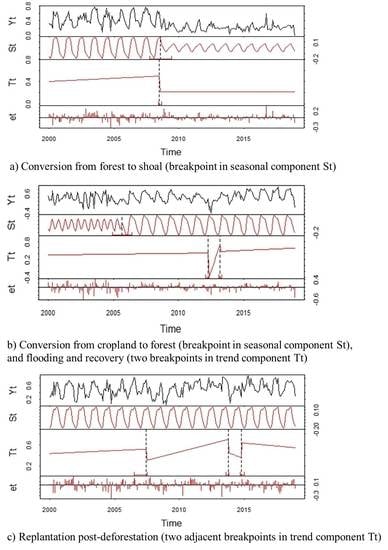Multi-Type Forest Change Detection Using BFAST and Monthly Landsat Time Series for Monitoring Spatiotemporal Dynamics of Forests in Subtropical Wetland
Abstract
:1. Introduction
2. Materials and Methods
2.1. Study Area
2.2. Methods
2.2.1. Datasets and Preprocessing
2.2.2. Breaks for Additive Seasonal and Trend
2.2.3. Land Cover Classification after Breakpoint Detection
2.2.4. Accuracy Assessment
2.2.5. Spatiotemporal Dynamics Analysis of Forest
3. Results
3.1. Accuracy Assessment
3.1.1. Accuracy Assessment for Change Detection
3.1.2. Accuracy Assessment for Classification
3.2. Spatiotemporal Dynamics of Forest
3.2.1. Duration and Spatial Distribution of Forest Plantation
3.2.2. Number of Abrupt Changes Related to Forest
3.2.3. Timing of Abrupt Changes Related to Forest
3.2.4. Variation of Forest Areas
4. Discussion
5. Conclusions
- (1)
- The forests are mainly distributed in the core zone surrounding the water body and the southwestern mountains. Over 60% of the stable forests are distributed in the transition zone, whereas the changed forests in the core zone and low elevation region are more prevalent.
- (2)
- Not only the proportion of pixels with FTF but also the number of FTF is higher than those of FTO and OTF. The forest change in the core zone is more frequent than that in the transition zone. Most changes occurred in the areas with DEM ranging from 20 to 40 m, in which the proportion of detected change number in the core zone is higher than that in the transition zone regardless of the change type.
- (3)
- Large parts of FTO occurred since 2011 due to the policy for protecting wetlands and restoring ecology. Some clear peaks of OTF were detected during 2000, 2012, 2016, and 2017 because of the jumping price of timber. FTF was relatively even for each year, except for one peak in 2017.
- (4)
- The variation of forest areas in the West Dongting Lake region experienced three steps: rapid expansion of forest plantation from 2000 to 2005, to which forest plantation in the core zone is the major contribution; relatively steady from 2006 to 2011, except for a small increase in the transition zone between 2008 and 2011; and continuous decline since 2011 with small sharp fluctuations in the core zone and a laggard downtrend in the transition zone. These variations were mainly caused by anthropogenic factors, such as the government policies and economic profits.
Author Contributions
Funding
Acknowledgments
Conflicts of Interest
References
- Hu, W.; Zhao, J.; He, J.; Li, Y. Land use change and its landscape effect around Dongting Lake in recently 15 years. J. Cent. South Univ. For. Technol. 2017, 37, 91–97. [Google Scholar]
- Davidson, N.C. How much wetland has the world lost Long-term and recent trends in global wetland area. Mar. Freshw. Res. 2014, 65, 934–941. [Google Scholar] [CrossRef]
- Hu, S.; Niu, Z.; Chen, Y.; Li, L.; Zhang, H. Global wetlands Potential distribution, wetland loss, and status. Sci. Total Environ. 2017, 586, 319–327. [Google Scholar] [CrossRef] [PubMed]
- Li, Y.; Qin, H.; Xie, Y.; Wang, W.; Chen, X.; Zhang, C. Physiological mechanism for the reduction in soil water in poplar (Populus deltoides) plantations in Dongting Lake wetlands. Wetl. Ecol. Manag. 2014, 22, 25–33. [Google Scholar] [CrossRef] [Green Version]
- Hu, Y.; Huang, J.; Deng, F. Using remote sensing to monitor wetland cover change and succession in Dongting Lake of China during 1993–2010. In Proceedings of the 2011 International Conference on Multimedia Technology, ICMT 2011, Hangzhou, China, 26–28 July 2011; pp. 5668–5672. [Google Scholar]
- Jing, L.; Lyu, C.; Zhou, Y.; Zuo, A.; Lei, G. Spatio-temporal characteristics of the expansion of poplar plantation in West Dongting Lake wetland, China. Chin. J. Appl. Ecol. 2016, 27, 2039–2047. [Google Scholar]
- Liu, Y.; Shi, L.; Duo, H.; Peng, B.; Lü, C.; Zhu, Y.; Lei, G. Disturbance-driven changes to landscape patterns and responses of waterbirds at West Dongting Lake, China. Biodivers. Sci. 2013, 21, 666–676. [Google Scholar]
- Li, Y.; Chen, X.; Xie, Y.; Li, X.; Li, F.; Hou, Z. Effects of young poplar plantations on understory plant diversity in the Dongting Lake wetlands, China. Sci. Rep. 2014, 4, 1–8. [Google Scholar] [CrossRef]
- Bruzzone, L.; Cossu, R.; Vernazza, G. Detection of land-cover transitions by combining multidate classifiers. Pattern Recognit. Lett. 2004, 25, 1491–1500. [Google Scholar] [CrossRef]
- Chen, J.; Chen, X.; Cui, X.; Chen, J. Change vector analysis in posterior probability space A new method for land cover change detection. IEEE Geosci. Remote Sens. Lett. 2011, 8, 317–321. [Google Scholar] [CrossRef]
- Lu, D.; Mausel, P.; Brondízio, E.; Moran, E. Change detection techniques. Int. J. Remote Sens. 2004, 25, 2365–2407. [Google Scholar] [CrossRef]
- Verbesselt, J.; Hyndman, R.; Newnham, G.; Culvenor, D. Detecting trend and seasonal changes in satellite image time series. Remote Sens. Environ. 2010, 114, 106–115. [Google Scholar] [CrossRef]
- Zhang, L.; Wu, C. Advance and Future development of change detection for multi-temporal remote sensing imagery. Acta Geod. Cartogr. Sin. 2017, 46, 1447–1459. [Google Scholar]
- Zhao, Z.; Meng, Y.; Yue, A.; Huang, Q.; Kong, Y.; Yuan, Y.; Liu, X.; Lin, L.; Zhang, M. Review of remotely sensed time series data for change detection. J. Remote Sens. 2016, 20, 1110–1125. [Google Scholar]
- Huang, C.; Goward, S.N.; Masek, J.G.; Thomas, N.; Zhu, Z.; Vogelmann, J.E. An automated approach for reconstructing recent forest disturbance history using dense Landsat time series stacks. Remote Sens. Environ. 2010, 114, 183–198. [Google Scholar] [CrossRef]
- Kennedy, R.E.; Yang, Z.; Cohen, W.B. Detecting trends in forest disturbance and recovery using yearly landsat time series: 1. LandTrendr-temporal segmentation algorithms. Remote Sens. Environ. 2010, 114, 2897–2910. [Google Scholar] [CrossRef]
- Griffiths, P.; Kuemmerle, T.; Kennedy, R.E.; Abrudan, I.V.; Knorn, J.; Hostert, P. Using annual time-series of Landsat images to assess the effects of forest restitution in post-socialist Romania. Remote Sens. Environ. 2012, 118, 199–214. [Google Scholar] [CrossRef]
- Kennedy, R.E.; Yang, Z.; Braaten, J.; Copass, C.; Antonova, N.; Jordan, C. Attribution of disturbance change agent from Landsat time-series in support of habitat monitoring in the Puget Sound region, USA. Remote Sens. Environ. 2015, 166, 271–285. [Google Scholar] [CrossRef]
- Wu, D.; Li, B.; Yang, A. Estimation of tree height and biomass based on long time series data of landsat. Eng. Sur. Map. 2017, 26, 1–5. [Google Scholar]
- Cai, S.; Liu, D. Detecting change dates from dense satellite time series using a sub-annual change detection algorithm. Remote Sens. 2015, 7, 8705–8727. [Google Scholar] [CrossRef] [Green Version]
- Zhu, Z.; Woodcock, C.E. Continuous change detection and classification of land cover using all available Landsat data. Remote Sens. Environ. 2014, 144, 152–171. [Google Scholar] [CrossRef] [Green Version]
- Boriah, S. Time Series Change Detection: Algorithms for Land Cover Change. Ph.D. Thesis, University of Minnesota, Minneapolis, MN, USA, January 2010. [Google Scholar]
- Verbesselt, J.; Hyndman, R.; Zeileis, A.; Culvenor, D. Phenological change detection while accounting for abrupt and gradual trends in satellite image time series. Remote Sens. Environ. 2010, 114, 2970–2980. [Google Scholar] [CrossRef] [Green Version]
- Chen, L.; Michishita, R.; Xu, B. Abrupt spatiotemporal land and water changes and their potential drivers in Poyang Lake, 2000–2012. ISPRS J. Photogramm. Remote Sens. 2014, 98, 85–93. [Google Scholar] [CrossRef]
- Platt, R.V.; Ogra, M.V.; Badola, R.; Hussain, S.A. Conservation-induced resettlement as a driver of land cover change in India an object-based trend analysis. Appl. Geogr. 2016, 69, 75–86. [Google Scholar] [CrossRef]
- Tsutsumida, N.; Saizen, I.; Matsuoka, M.; Ishii, R. Land Cover Change Detection in Ulaanbaatar Using the Breaks for Additive Seasonal and Trend Method. Land 2013, 2, 534–549. [Google Scholar] [CrossRef]
- Dutrieux, L.P.; Verbesselt, J.; Kooistra, L.; Herold, M. Monitoring forest cover loss using multiple data streams, a case study of a tropical dry forest in Bolivia. ISPRS J. Photogramm. Remote Sens. 2015, 107, 112–125. [Google Scholar] [CrossRef]
- Fang, X.; Zhu, Q.; Ren, L.; Chen, H.; Wang, K.; Peng, C. Large-scale detection of vegetation dynamics and their potential drivers using MODIS images and BFAST: A case study in Quebec, Canada. Remote Sens. Environ. 2018, 206, 391–402. [Google Scholar] [CrossRef]
- Verbesselt, J.; Zeileis, A.; Herold, M. Near real-time disturbance detection using satellite image time series. Remote Sens. Environ. 2012, 123, 98–108. [Google Scholar] [CrossRef]
- Saxena, R.; Watson, L.T.; Wynne, R.H.; Brooks, E.B.; Thomas, V.A.; Yang, Z.; Kennedy, R.E. Towards a polyalgorithm for land use change detection. ISPRS J. Photogramm. Remote Sens. 2018, 144, 217–234. [Google Scholar] [CrossRef]
- Waller, E.K.; Villarreal, M.L.; Poitras, T.B.; Nauman, T.W.; Duniway, M.C. Landsat time series analysis of fractional plant cover changes on abandoned energy development sites. Int. J. Appl. Earth Obs. Geoinf. 2018, 73, 407–419. [Google Scholar] [CrossRef]
- Yuan, Y.; Meng, Y.; Lin, L.; Sahli, H.; Yue, A.; Chen, J.; Zhao, Z.; Kong, Y.; He, D. Continuous Change Detection and Classification Using Hidden Markov Model: A Case Study for Monitoring Urban Encroachment onto Farmland in Beijing. Remote Sens. 2015, 7, 15318–15339. [Google Scholar] [CrossRef] [Green Version]
- Chen, J.; Chen, J.; Liu, H.; Peng, S. Detection of cropland change using multi-harmonic based phenological trajectory similarity. Remote Sens. 2018, 10, 1020. [Google Scholar] [CrossRef] [Green Version]
- Jin, S.; Sader, S.A. MODIS time-series imagery for forest disturbance detection and quantification of patch size effects. Remote Sens. Environ. 2005, 99, 462–470. [Google Scholar] [CrossRef]
- Hansen, M.C.; Potapov, P.V.; Moore, R.; Hancher, M.; Turubanova, S.A.; Tyukavina, A.; Thau, D.; Stehman, S.V.; Goetz, S.J.; Loveland, T.R.; et al. High-resolution global maps of 21st-century forest cover change. Science 2013, 342, 850–853. [Google Scholar] [CrossRef] [PubMed] [Green Version]
- Townshend, J.R.; Masek, J.G.; Huang, C.; Vermote, E.F.; Gao, F.; Channan, S.; Sexton, J.O.; Feng, M.; Narasimhan, R.; Kim, D.; et al. Global characterization and monitoring of forest cover using Landsat data opportunities and challenges. Int. J. Digit. Earth 2013, 5, 373–397. [Google Scholar] [CrossRef] [Green Version]
- Loveland, T.R.; Irons, J.R. Landsat 8: The plans, the reality, and the legacy. Remote Sens. Environ. 2016, 185, 1–6. [Google Scholar] [CrossRef] [Green Version]
- Wulder, M.A.; White, J.C.; Loveland, T.R.; Woodcock, C.E.; Belward, A.S.; Cohen, W.B.; Fosnight, E.A.; Shaw, J.; Masek, J.G.; Roy, D.P. The global Landsat archive Status, consolidation, and direction. Remote Sens. Environ. 2016, 185, 271–283. [Google Scholar] [CrossRef] [Green Version]
- Vogelmann, J.E.; Gallant, A.L.; Shi, H.; Zhu, Z. Perspectives on monitoring gradual change across the continuity of Landsat sensors using time-series data. Remote Sens. Environ. 2016, 185, 258–270. [Google Scholar] [CrossRef] [Green Version]
- Chen, J.; Zhu, X.; Vogelmann, J.E.; Gao, F.; Jin, S. A simple and effective method for filling gaps in Landsat ETM+ SLC-off images. Remote Sens. Environ. 2011, 115, 1053–1064. [Google Scholar] [CrossRef]
- Zhu, X.; Gao, F.; Liu, D.; Chen, J. A modified neighborhood similar pixel interpolator approach for removing thick clouds in landsat images. IEEE Geosci. Remote Sens. Lett. 2012, 9, 521–525. [Google Scholar] [CrossRef]
- Zhu, X.; Helmer, E.H.; Chen, J.; Liu, D. An Automatic System for Reconstructing High-Quality Seasonal Landsat Time Series. In Remote Sensing Time Series Image Processing; Taylor and Francis Series in Imaging Science; Weng, Q., Ed.; CRC Press: Boca Raton, FL, USA, 2018; pp. 25–42. [Google Scholar]
- Zhu, X.; Chen, J.; Gao, F.; Chen, X.; Masek, J.G. An enhanced spatial and temporal adaptive reflectance fusion model for complex heterogeneous regions. Remote Sens. Environ. 2010, 114, 2610–2623. [Google Scholar] [CrossRef]
- Liu, M.; Liu, X.; Wu, L.; Zou, X.; Jiang, T.; Zhao, B. A Modified spatiotemporal fusion algorithm using phenological information for predicting reflectance of paddy rice in southern China. Remote Sens. 2018, 10, 772. [Google Scholar] [CrossRef] [Green Version]
- The United States Geological Service (USGS) LSDS Science Research and Development (LSRD). Available online: https://espa.cr.usgs.gov (accessed on 10 January 2020).
- National Aeronautics and Space Administration (NASA) Level-1 and Atmosphere Archive & Distribution System Distributed Active Archive Center (LAADSDAAC). Available online: https://ladsweb.modaps.eosdis.nasa.gov (accessed on 10 January 2020).
- National Aeronautics and Space Administration (NASA) Land Processes Distributed Active Archive Center (LPDAAC). Available online: https://lpdaac.usgs.gov/ (accessed on 10 January 2020).
- Cleveland, R.B.; Cleveland, W.S.; McRae, J.E. STL: A seasonal trend decomposition procedure based on loess. J. Off. Statist. 1990, 6, 3–73. [Google Scholar]
- Chu, C.S.J.; Hornik, K.; Kaun, C.M. MOSUM tests for parameter constancy. Br. J. Psychiatry 1995, 112, 211–212. [Google Scholar] [CrossRef]
- Schwarz, G. Estimating the dimension of a model. Ann. Stat. 1978, 14, 590–606. [Google Scholar] [CrossRef]
- Venables, W.N.; Ripley, B.D. Modern Applied Statistics with S-PLUS.; Springer: Berlin/Heidelberg, Germany, 2002; pp. 156–163. [Google Scholar]
- Breiman, L. Random Forests. Mach. Learn. 2001, 45, 5–32. [Google Scholar] [CrossRef] [Green Version]
- Gómez, C.; White, J.C.; Wulder, M.A. Optical remotely sensed time series data for land cover classification: A review. ISPRS J. Photogramm. Remote Sens. 2016, 116, 55–72. [Google Scholar] [CrossRef] [Green Version]
- Cohen, W.B.; Yang, Z.; Kennedy, R. Detecting trends in forest disturbance and recovery using yearly Landsat time series: 2. TimeSync—Tools for calibration and validation. Remote Sens. Environ. 2010, 114, 2911–2924. [Google Scholar] [CrossRef]
- Grogan, K.; Pflugmacher, D.; Hostert, P.; Kennedy, R.; Fensholt, R. Cross-border forest disturbance and the role of natural rubber in main-land Southeast Asia using annual Landsat time series. Remote Sens. Environ. 2015, 169, 438–453. [Google Scholar] [CrossRef]
- Jin, S.; Yang, L.; Danielson, P.; Homer, C.; Fry, J.; Xian, G. A comprehensive change detection method for updating the national land cover database to circa 2011. Remote Sens. Environ. 2013, 132, 159–175. [Google Scholar] [CrossRef] [Green Version]
- DeVries, B.; Verbesselt, J.; Kooistra, L.; Herold, M. Robust monitoring of small-scale forest disturbances in a tropical montane forest using Landsat time series. Remote Sens. Environ. 2015, 161, 107–121. [Google Scholar] [CrossRef]
- Zhu, Z. Change detection using landsat time series: A review of frequencies, preprocessing, algorithms, and applications. ISPRS J. Photogramm. Remote Sens. 2017, 130, 370–384. [Google Scholar] [CrossRef]
- Hamunyela, E.; Verbesselt, J.; Herold, M. Using spatial context to improve early detection of deforestation from Landsat time series. Remote Sens. Environ. 2016, 172, 126–138. [Google Scholar] [CrossRef]
- Hermosilla, T.; Wulder, M.A.; White, J.C.; Coops, N.C.; Hobart, G.W. Regional detection, characterization, and attribution of annual forest change from 1984 to 2012 using Landsat-derived time-series metrics. Remote Sens. Environ. 2015, 170, 121–132. [Google Scholar] [CrossRef]
- Behling, R.; Milewski, R.; Chabrillat, S. Spatiotemporal shoreline dynamics of Namibian coastal lagoons derived by a dense remote sensing time series approach. Int. J. Appl. Earth Obs. Geoinf. 2018, 68, 262–271. [Google Scholar] [CrossRef] [Green Version]
- Guttler, F.; Ienco, D.; Nin, J.; Teisseire, M.; Poncelet, P. A graph-based approach to detect spatiotemporal dynamics in satellite image time series. ISPRS J. Photogramm. Remote Sens. 2017, 130, 92–107. [Google Scholar] [CrossRef] [Green Version]
- De Beurs, K.M.; Henebry, G.M. A statistical framework for the analysis of long image time series. Int. J. Remote Sens. 2005, 26, 1551–1573. [Google Scholar] [CrossRef]
- Lu, M.; Pebesma, E.; Sanchez, A.; Verbesselt, J. Spatio-temporal change detection from multidimensional arrays Detecting deforestation from MODIS time series. ISPRS J. Photogramm. Remote Sens. 2016, 117, 227–236. [Google Scholar] [CrossRef]
- Coulibaly, S.; Kamsu-Foguem, B.; Kamissoko, D.; Traore, D. Deep neural networks with transfer learning in millet crop images. Comput. Ind. 2019, 108, 115–120. [Google Scholar] [CrossRef] [Green Version]
- Pan, X.; Zhao, J. A central-point-enhanced convolutional neural network for high-resolution remote-sensing image classification. Int. J. Remote Sens. 2017, 38, 6554–6581. [Google Scholar] [CrossRef]
- Zhao, S.; Liu, X.; Ding, C.; Liu, S.; Wu, C.; Wu, L. Mapping Rice Paddies in Complex Landscapes with Convolutional Neural Networks and Phenological Metrics. GISci. Remote Sens. 2019. [Google Scholar] [CrossRef]
- Jiang, T.; Liu, X.; Wu, L. Method for Mapping Rice Fields in Complex Landscape Areas Based on Pre-Trained Convolutional Neural Network from HJ-1 A/B Data. ISPRS Int. Geo-Inf. 2018, 7, 418. [Google Scholar] [CrossRef] [Green Version]
- Wang, L.; Liu, M.; Liu, X.; Wu, L.; Wang, P.; Wu, C. Hierarchical classification method for mapping rice-cropping systems using pretrained convolutional neural network with spatial and spectral trajectories of Sentinel-2 time series. J. Appl. Remote Sens. 2020, 14, 014506. [Google Scholar] [CrossRef]
- Google Earth Engine (GEE) Platform. Available online: https://earthengine.google.org/ (accessed on 10 January 2020).
- Dong, J.; Xiao, X.; Menarguez, M.A.; Zhang, G.; Qin, Y.; Thau, D. Mapping paddy rice planting area in northeastern Asia with Landsat 8 images, phenology-based algorithm and Google Earth Engine. Remote Sens. Environ. 2016, 185, 142–154. [Google Scholar] [CrossRef] [PubMed] [Green Version]
- Zhu, L.; Liu, X.; Wu, L.; Tang, Y.; Meng, Y. Long-Term Monitoring of Cropland Change near Dongting Lake, China, Using the LandTrendr Algorithm with Landsat Imagery. Remote Sens. 2019, 11, 1234. [Google Scholar] [CrossRef] [Green Version]
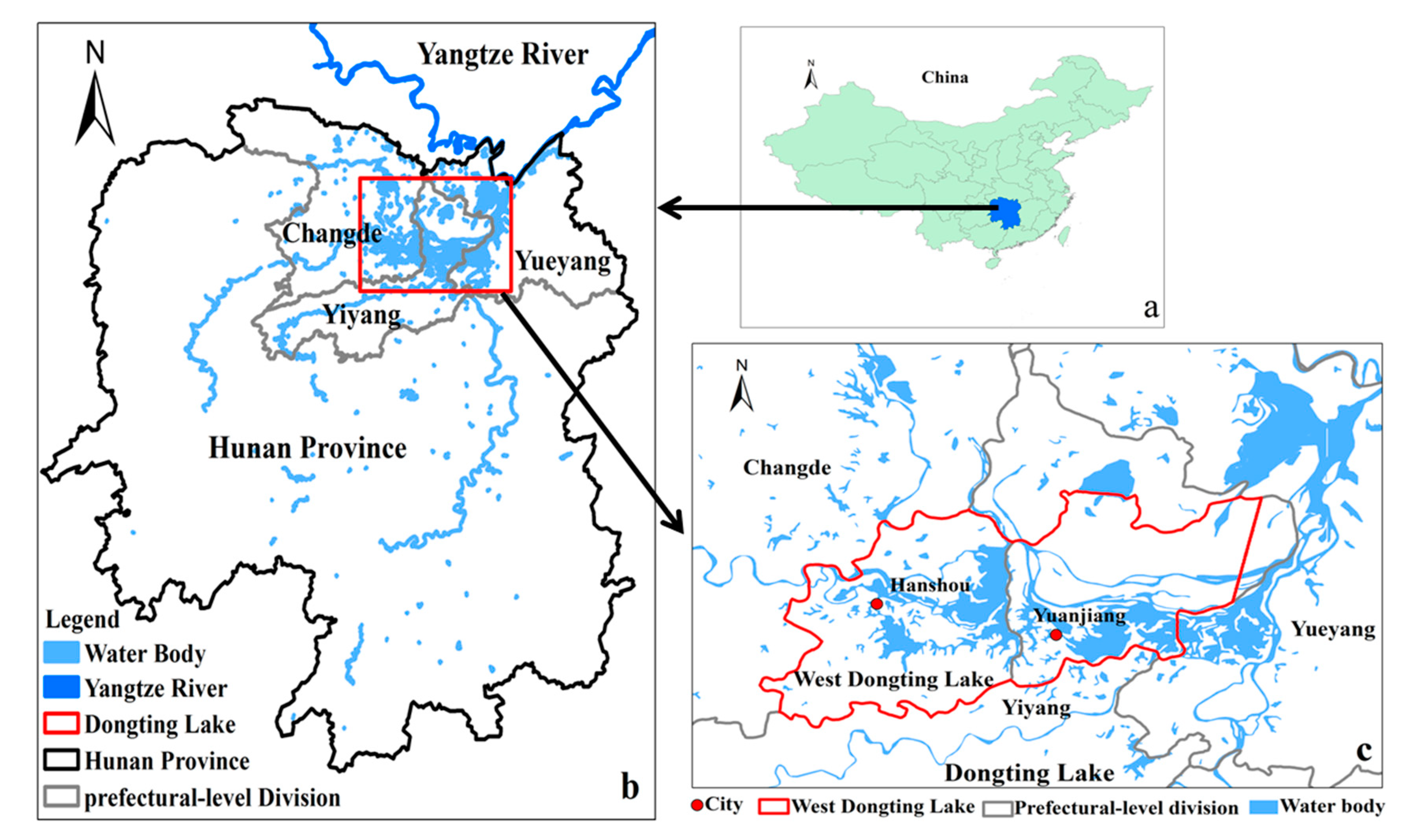
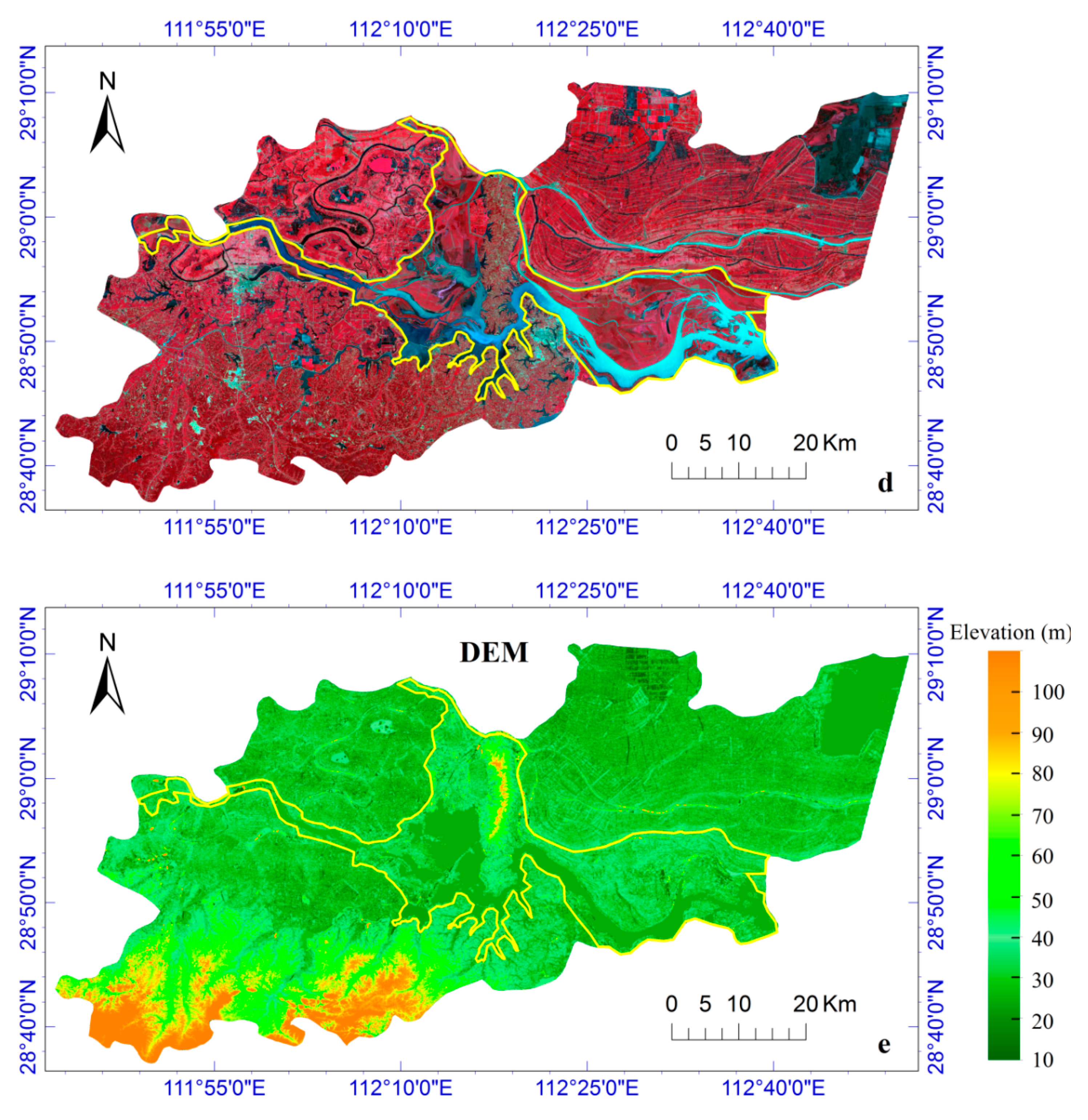
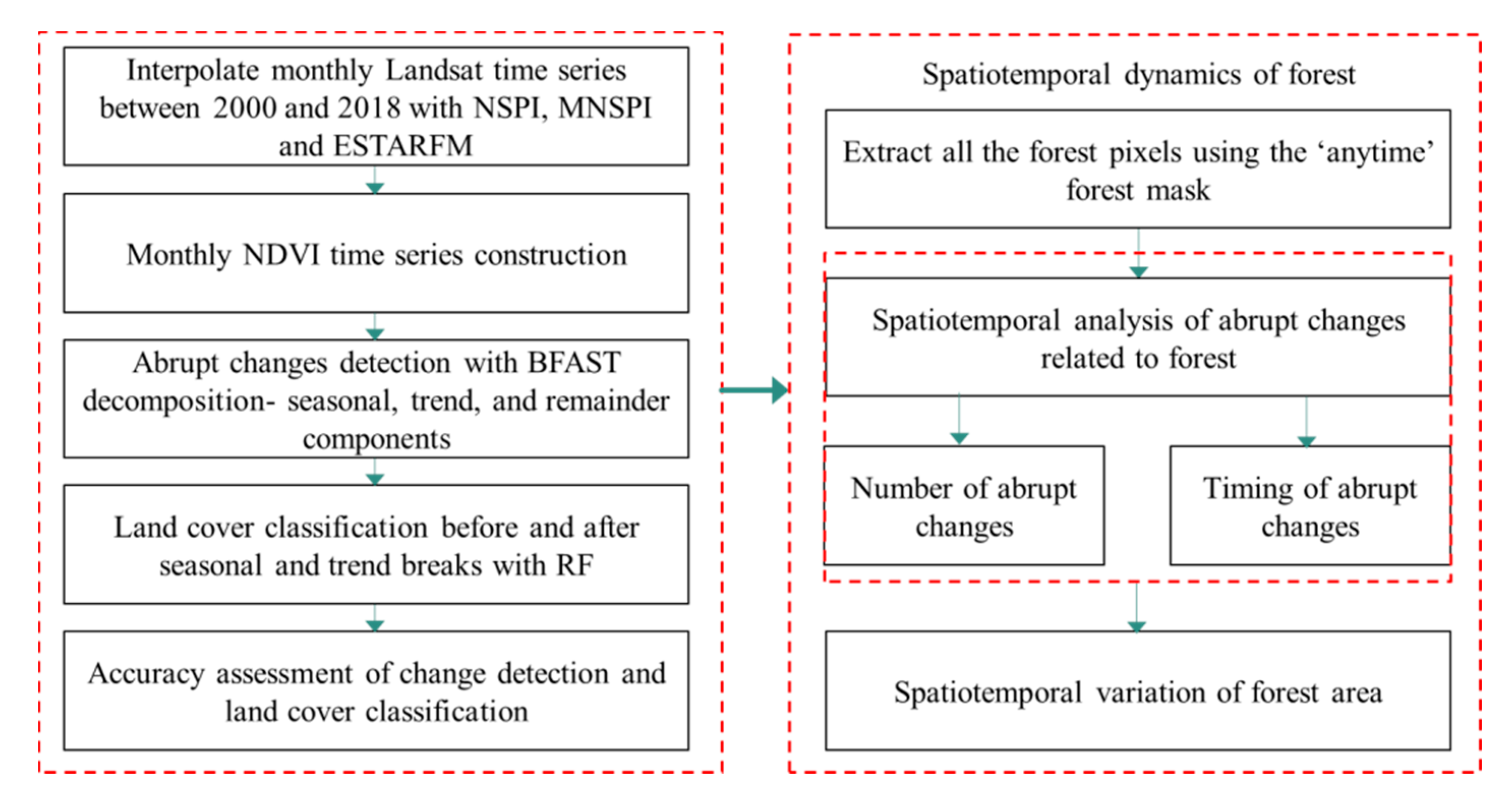
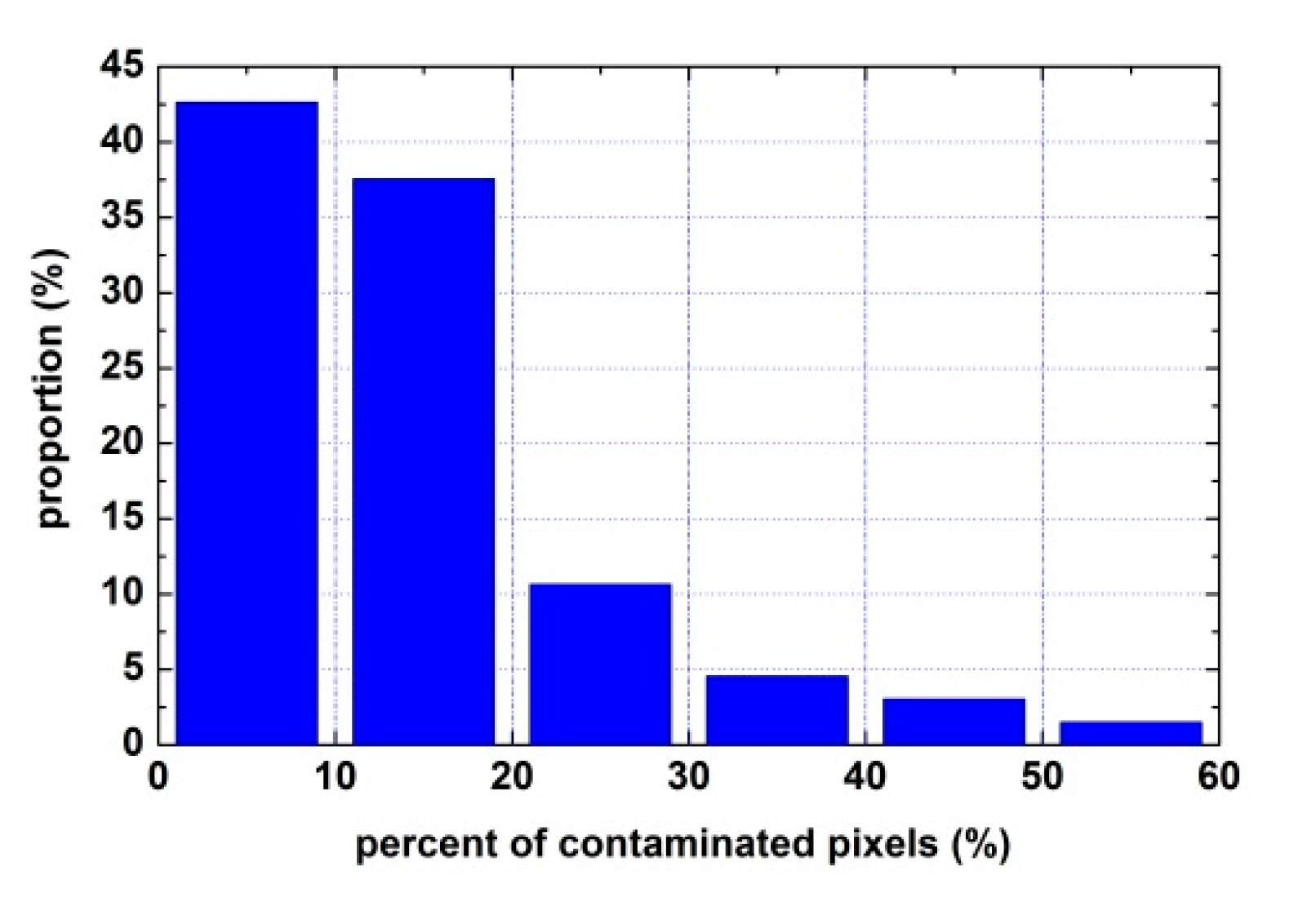
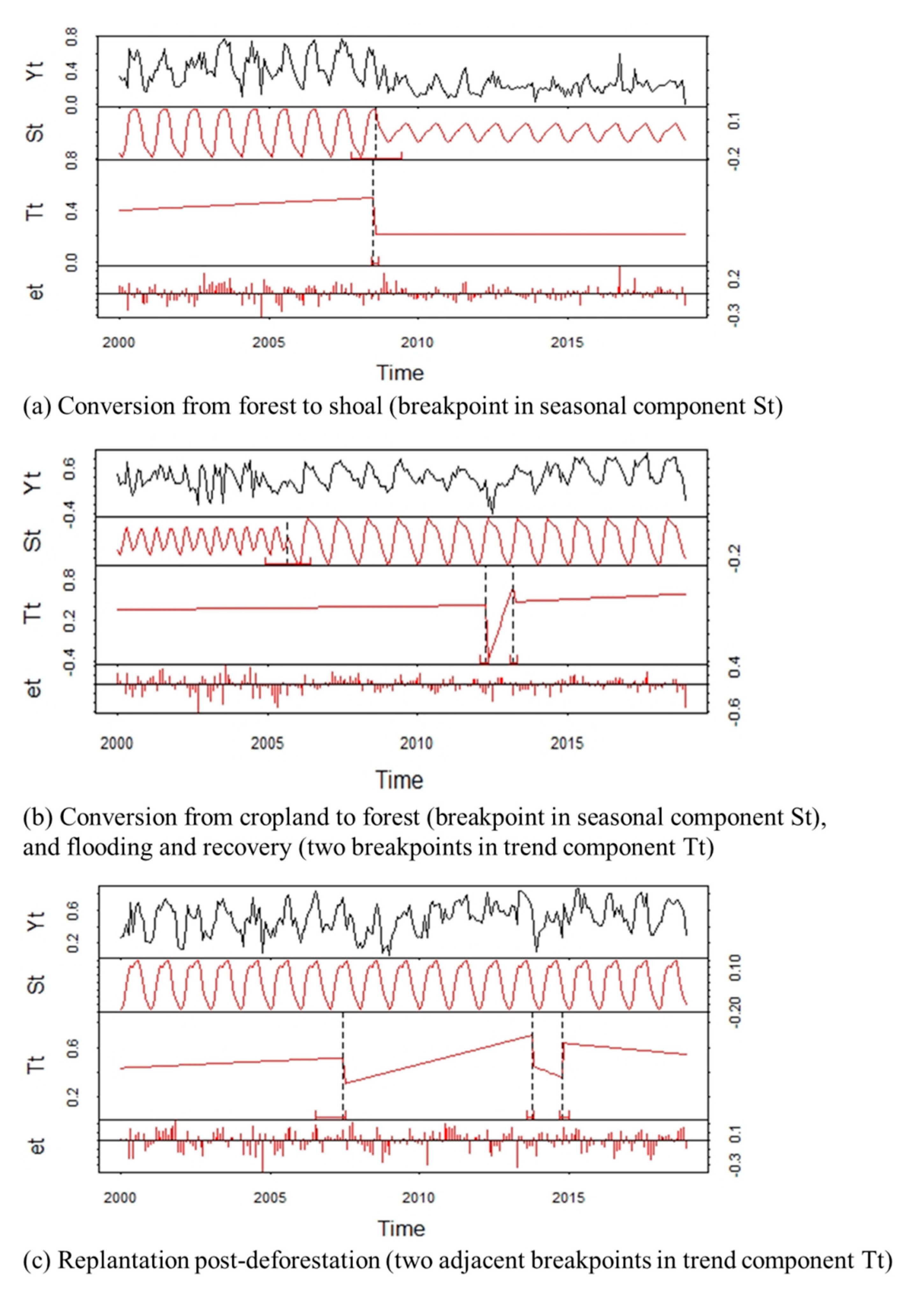
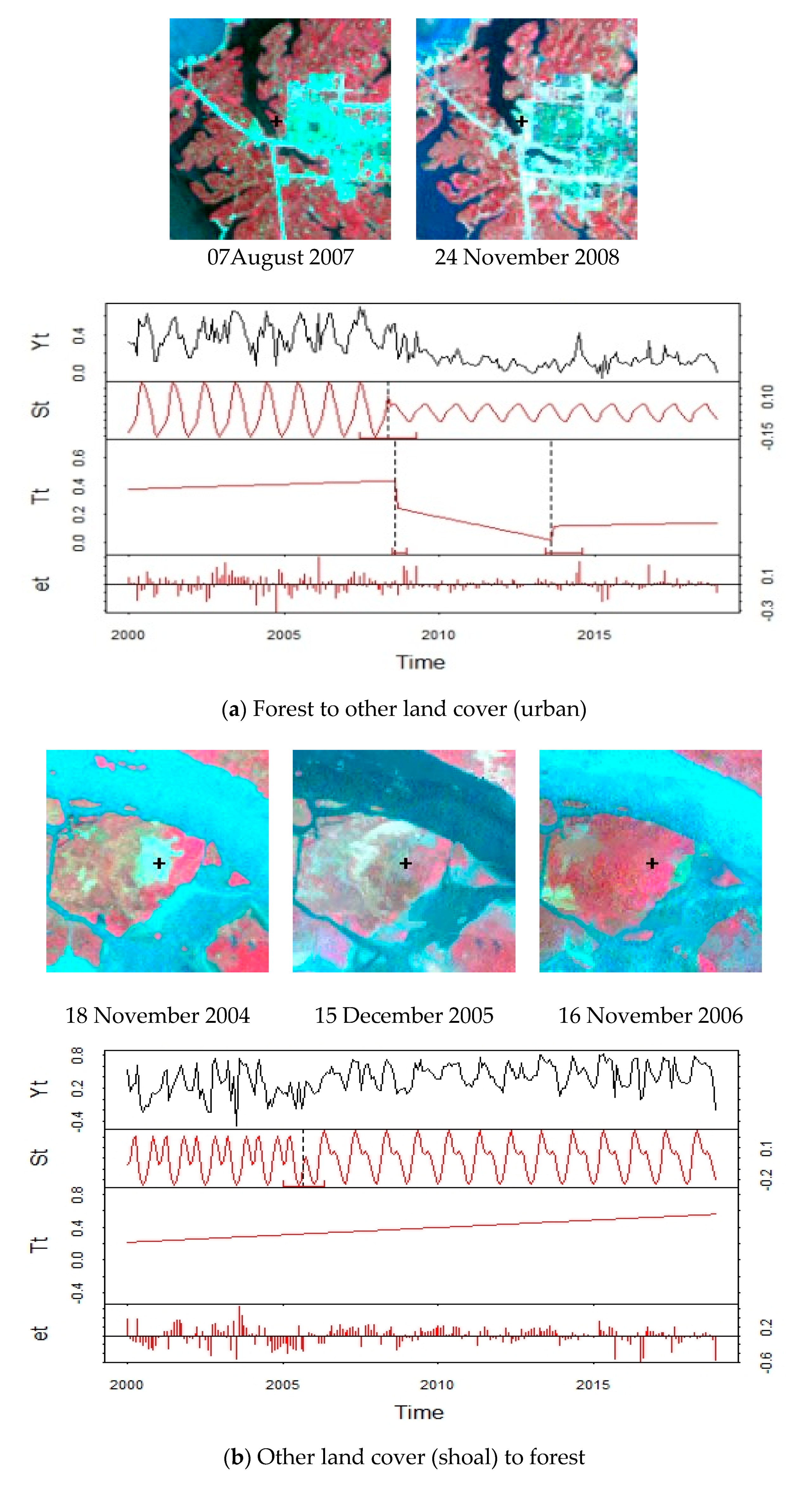





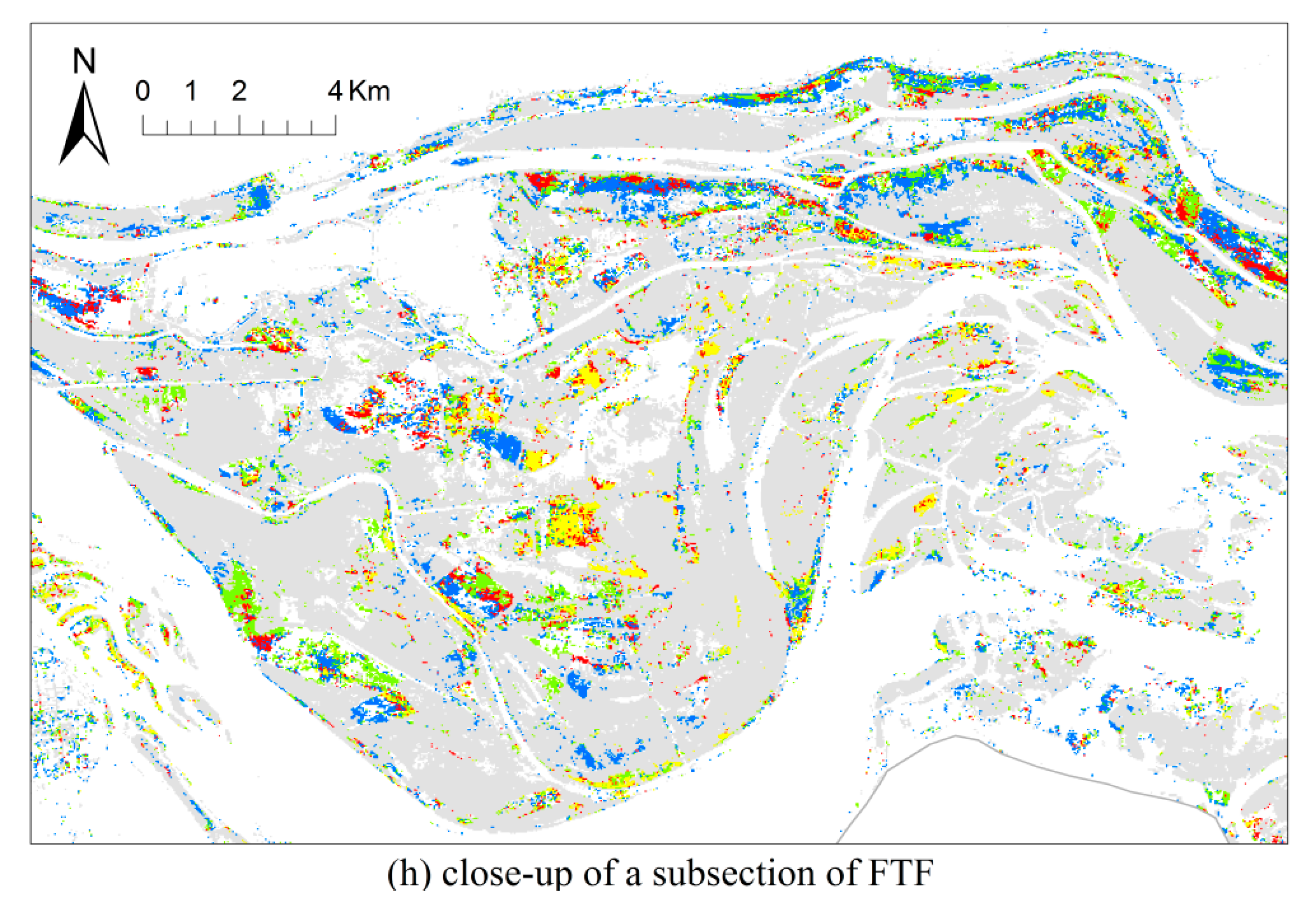
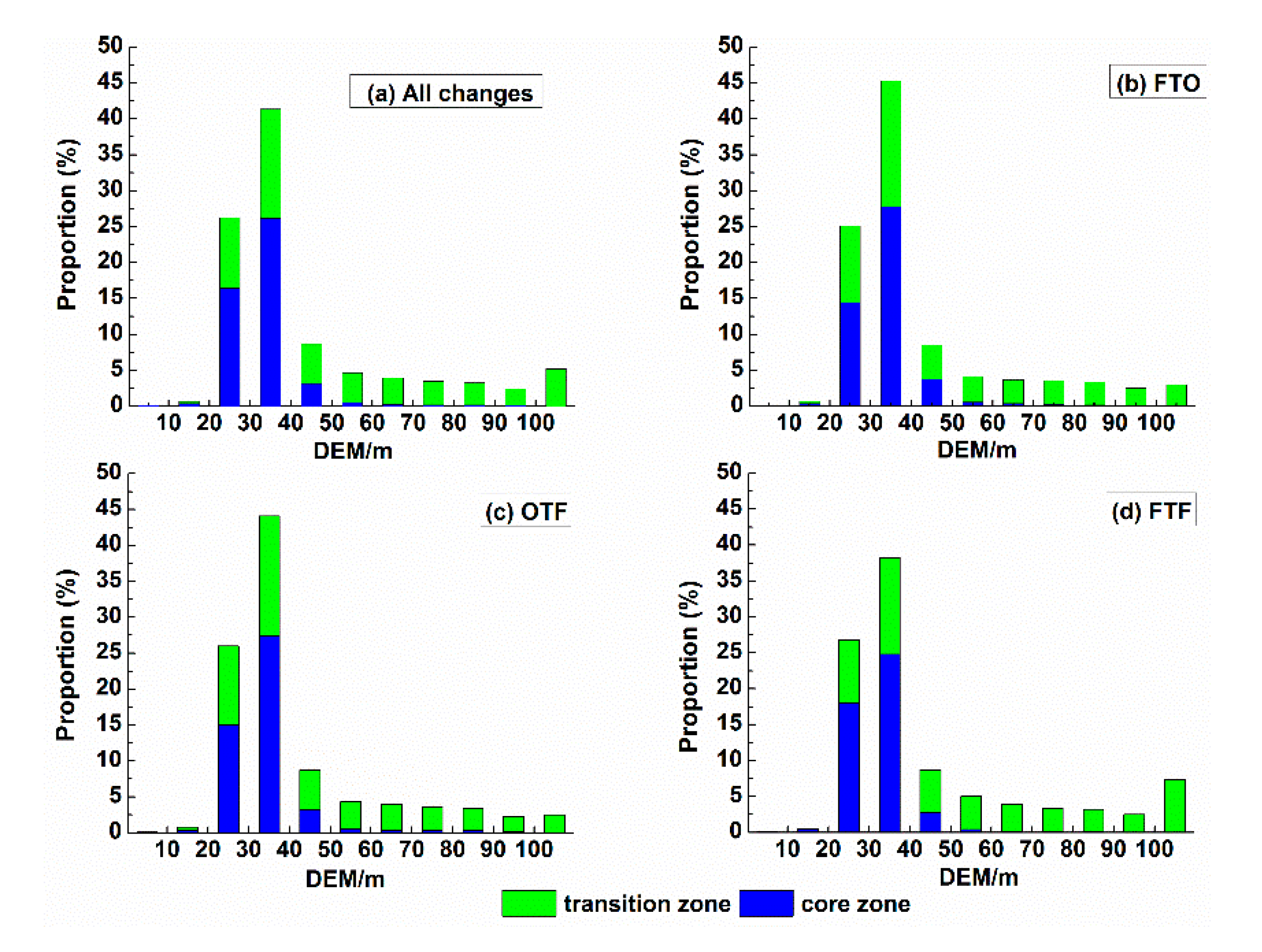

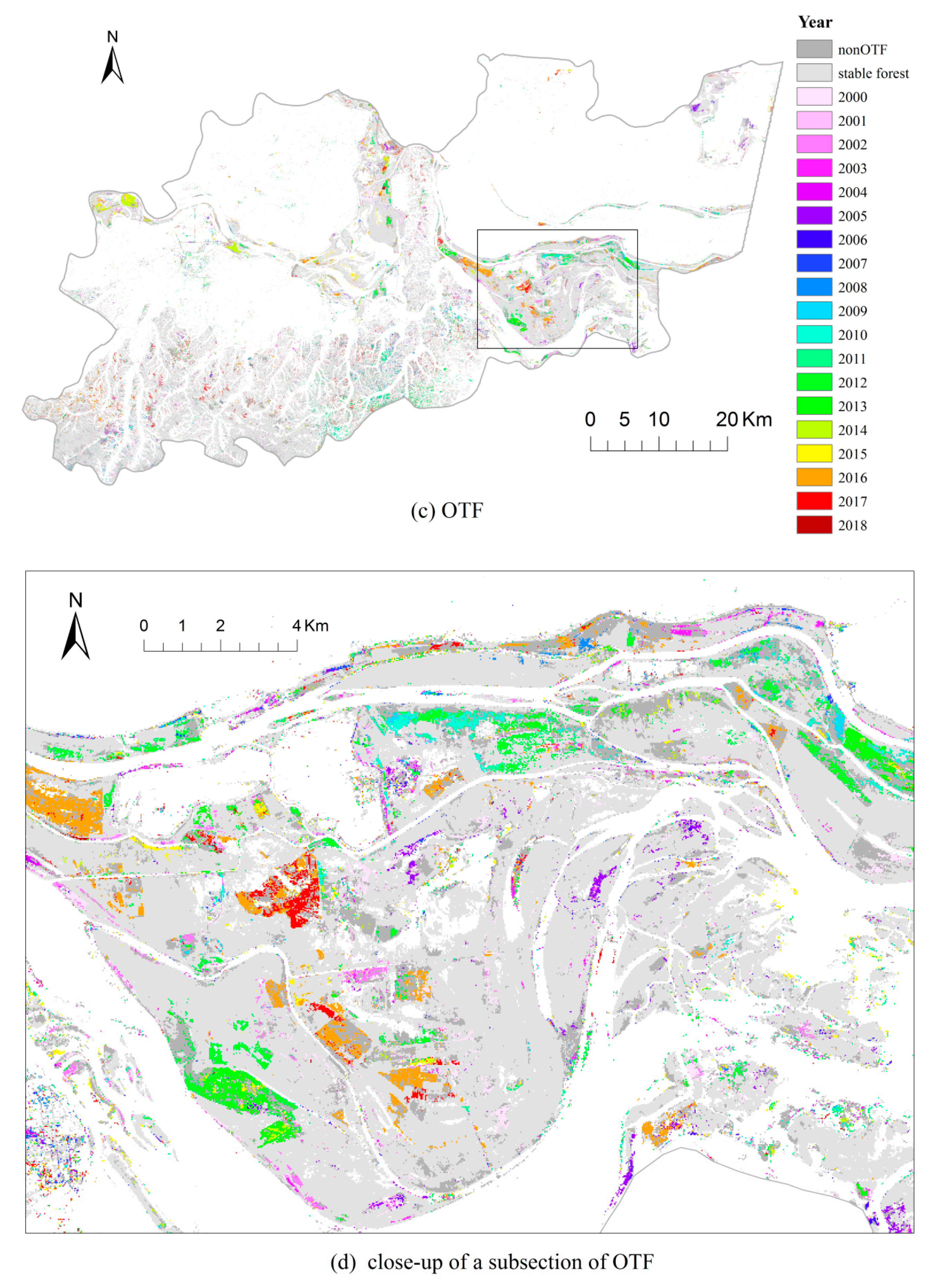


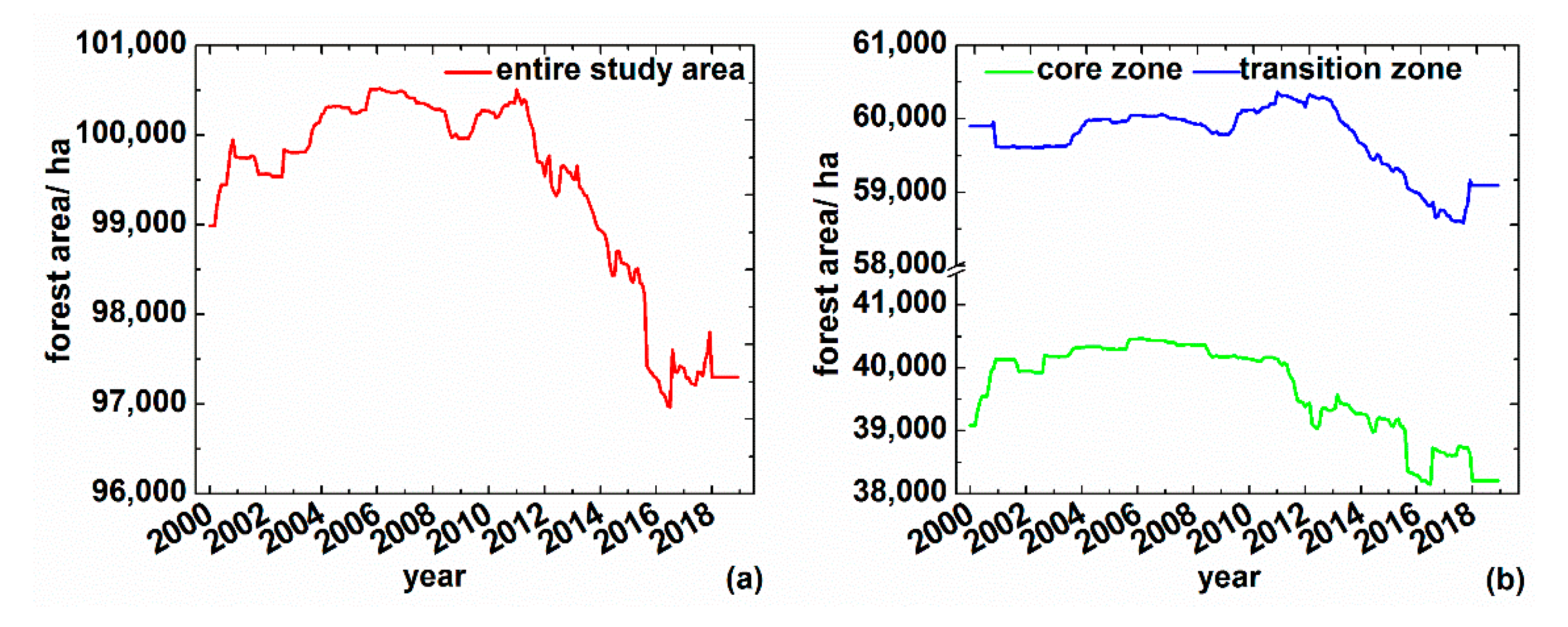
| Year | Number of Available Images | Number of Missing Images |
|---|---|---|
| 2000 | 9 | 4 |
| 2001 | 11 | 2 |
| 2002 | 10 | 2 |
| 2003 | 5 | 7 |
| 2004 | 15 | 1 |
| 2005 | 10 | 3 |
| 2006 | 9 | 3 |
| 2007 | 8 | 5 |
| 2008 | 12 | 1 |
| 2009 | 13 | 3 |
| 2010 | 10 | 3 |
| 2011 | 11 | 5 |
| 2012 | 7 | 6 |
| 2013 | 11 | 2 |
| 2014 | 10 | 4 |
| 2015 | 10 | 3 |
| 2016 | 12 | 2 |
| 2017 | 12 | 3 |
| 2018 | 12 | 0 |
| total | 197 | 59 |
| Data | Description | Source |
|---|---|---|
| Landsat 5, 7 and 8 | All 197 available Landsat images (Table 1) used as inputs to NSPI and MNSPI for SLC-off gaps filling and cloud removal. One-hundred-and-sixty-nine out of 197 images and 59 prediction images reconstructed with ESTARFM, a total of 228 images, utilized to generate a monthly Landsat time series for change detection with BFAST. | (1) The United States Geological Service (USGS) [45]; (2) prediction images reconstructed with ESTARFM. |
| MODIS | Seventy-three MODIS surface reflectance 8-day composite images used as inputs to ESTARFM for reconstructing the 59 missing Landsat images. | National Aeronautics and Space Administration (NASA) Level-1 and Atmosphere Archive & Distribution System Distributed Active Archive Center (LAADSDAAC) [46]. |
| High-resolution images | Images for validation of change detection and land cover classification, and determination of land cover category of each reference pixel with Landsat images together. | Google earth |
| GDEM | ASTER GDEM version 2.0 data with 1 arc-second grid used for analyzing spatiotemporal dynamics of forest. | NASA Land Processes Distributed Active Archive Center (LPDAAC) [47]. |
| Class | Date | Total | |||
|---|---|---|---|---|---|
| 2002-09-02 | 2007-08-07 | 2013-08-07 | 2017-08-18 | ||
| Crop | 1066 | 1397 | 1066 | 1896 | 5425 |
| Forest | 1091 | 1204 | 1091 | 1505 | 4891 |
| Shoal | 161 | 126 | 188 | 190 | 665 |
| Urban | 2959 | 2957 | 2959 | 1521 | 10,396 |
| Water | 1080 | 1008 | 1080 | 1592 | 4760 |
| Total | 6357 | 6692 | 6384 | 6704 | 26,137 |
| Category | Indicator | Formula | Meaning/Explanation |
|---|---|---|---|
| Duration | The duration proportion Df of forest plantation in each pixel | TPf represents the number of time phases when the land cover category within the pixel is forest; 228 is the total number of time phases (or images) within the monthly Landsat time series | |
| Proportion of stable (Ps) and changed forests (Pc) | Nc and Ns represent the number of changed and stable forest pixels, respectively Nf represents the number of forest pixels | ||
| Number | Number iK of abrupt changes [24] | K represents the change type | |
| Number Nc(i) and proportion Pc(i) of changed pixels with i times abrupt changes | |||
| Proportion ML of abrupt changes in region L | represents the number of changed pixels with i times abrupt changes in region L represents the total number of abrupt changes | ||
| The ratio RL of the number of abrupt changes to the number of changed pixels in region L | represents the number of change pixels in region L | ||
| Timing | Timing (Tl) of last change [25] | ||
| Annual proportion APK,T of abrupt changes [24] | The ratio of the number of changes in a certain year to the total number of changes. represents the number of changed pixels with i times change type K in T | ||
| Areas | forest areas AL,t in region L in t | represents the number of forest pixels in region L in t. s is the area of one Landsat pixel (900 m2) |
| Changed Pixels | Stable Pixels | Total | User’s Accuracy | |
|---|---|---|---|---|
| Changed pixels | 253 | 47 | 300 | 84.3% |
| Stable pixels | 26 | 274 | 300 | 91.3% |
| Total | 279 | 321 | ||
| Producer’s accuracy | 90.7% | 85.4% | Overall | 87.8% |
| Same time | Late ≤ 2 months | Late > 2 months | Total | |
|---|---|---|---|---|
| Changed pixels | 196 | 33 | 24 | 253 |
| proportion | 77.47% | 13.04% | 9.49% | 100% |
| Overall Accuracy = 7285/7837 = 92.96% Kappa Coefficient = 0.9026 | ||||||
|---|---|---|---|---|---|---|
| Ground Truth (Pixels) | ||||||
| Class | Crop | Forest | Shoal | Urban | Water | User Accuracy |
| crop | 1500 | 48 | 0 | 35 | 38 | 92.54% |
| forest | 20 | 1338 | 45 | 22 | 15 | 92.92% |
| shoal | 0 | 10 | 141 | 0 | 1 | 92.76% |
| urban | 109 | 42 | 2 | 3049 | 113 | 91.98% |
| water | 18 | 7 | 4 | 23 | 1257 | 96.03% |
| Total | 1647 | 1445 | 192 | 3129 | 1424 | |
| Producer accuracy | 91.07% | 92.60% | 73.44% | 97.44% | 88.27% | |
| Location | Type | DEM (m) | Total | ||||
|---|---|---|---|---|---|---|---|
| ≤20 | 20–30 | 30–40 | 40–50 | ≥50 | |||
| Core zone | Changed forest | 0.12 | 3.89 | 6.46 | 0.81 | 0.4 | 11.69 |
| Stable forest | 0.20 | 10.04 | 14.24 | 2.02 | 1.13 | 27.63 | |
| Transition zone | Changed forest | 0.08 | 2.75 | 4.66 | 1.86 | 6.88 | 16.23 |
| Stable forest | 0.07 | 3.68 | 8.15 | 5 | 27.55 | 44.45 | |
| total | Changed forest | 0.20 | 6.64 | 11.12 | 2.67 | 7.28 | 27.92 |
| Stable forest | 0.27 | 13.72 | 22.39 | 7.02 | 28.68 | 72.08 | |
| proportion of changed forest | 42.55 | 32.61 | 33.18 | 27.55 | 20.24 | ||
| Number of Abrupt Changes | All | FTO | OTF | FTF | ||||
|---|---|---|---|---|---|---|---|---|
| Number | Proportion (%) | Number | Proportion (%) | Number | Proportion (%) | Number | Proportion (%) | |
| 0 | 851,172 | 72.08 | 1,023,095 | 86.64 | 1,040,505 | 88.11 | 995,485 | 84.30 |
| 1 | 125,277 | 10.61 | 145,754 | 12.34 | 129,876 | 11.00 | 91,530 | 7.75 |
| 2 | 122,404 | 10.37 | 11,665 | 0.99 | 9897 | 0.84 | 56,196 | 4.76 |
| 3 | 51,649 | 4.37 | 375 | 0.03 | 609 | 0.05 | 21,962 | 1.86 |
| ≥4 | 30,391 | 2.57 | 4 | 0.00 | 6 | 0.00 | 15,720 | 1.33 |
| TCP 1 | 329,721 | 27.92 | 157,798 | 13.36 | 140,388 | 11.89 | 185,408 | 15.70 |
| TNB 2 | 665,744 | 170,225 | 151,521 | 343,998 | ||||
© 2020 by the authors. Licensee MDPI, Basel, Switzerland. This article is an open access article distributed under the terms and conditions of the Creative Commons Attribution (CC BY) license (http://creativecommons.org/licenses/by/4.0/).
Share and Cite
Wu, L.; Li, Z.; Liu, X.; Zhu, L.; Tang, Y.; Zhang, B.; Xu, B.; Liu, M.; Meng, Y.; Liu, B. Multi-Type Forest Change Detection Using BFAST and Monthly Landsat Time Series for Monitoring Spatiotemporal Dynamics of Forests in Subtropical Wetland. Remote Sens. 2020, 12, 341. https://doi.org/10.3390/rs12020341
Wu L, Li Z, Liu X, Zhu L, Tang Y, Zhang B, Xu B, Liu M, Meng Y, Liu B. Multi-Type Forest Change Detection Using BFAST and Monthly Landsat Time Series for Monitoring Spatiotemporal Dynamics of Forests in Subtropical Wetland. Remote Sensing. 2020; 12(2):341. https://doi.org/10.3390/rs12020341
Chicago/Turabian StyleWu, Ling, Zhaoliang Li, Xiangnan Liu, Lihong Zhu, Yibo Tang, Biyao Zhang, Boliang Xu, Meiling Liu, Yuanyuan Meng, and Boyuan Liu. 2020. "Multi-Type Forest Change Detection Using BFAST and Monthly Landsat Time Series for Monitoring Spatiotemporal Dynamics of Forests in Subtropical Wetland" Remote Sensing 12, no. 2: 341. https://doi.org/10.3390/rs12020341
APA StyleWu, L., Li, Z., Liu, X., Zhu, L., Tang, Y., Zhang, B., Xu, B., Liu, M., Meng, Y., & Liu, B. (2020). Multi-Type Forest Change Detection Using BFAST and Monthly Landsat Time Series for Monitoring Spatiotemporal Dynamics of Forests in Subtropical Wetland. Remote Sensing, 12(2), 341. https://doi.org/10.3390/rs12020341





